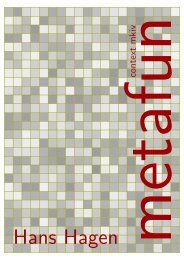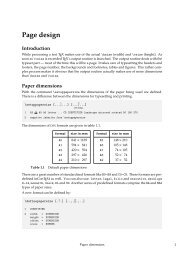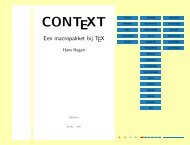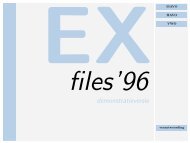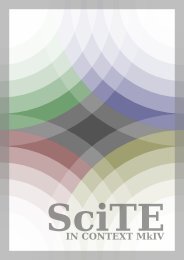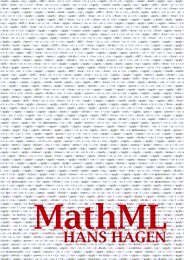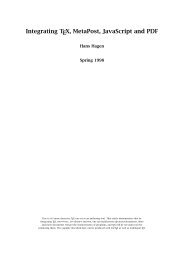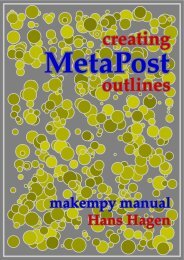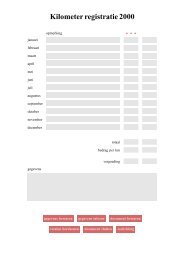You also want an ePaper? Increase the reach of your titles
YUMPU automatically turns print PDFs into web optimized ePapers that Google loves.
CHEMML<br />
ConT E Xt XML<br />
<strong>Pragma</strong> <strong>ADE</strong> / Hasselt NL
Description<br />
Structure<br />
<strong>ChemML</strong> 1<br />
The chemical XML markup dialect provided by CONTEXT is relatively simple, but sufficient for<br />
everyday chemistry. Of course we have elements that represent the building blocks of chemistry:<br />
• atoms<br />
• ions<br />
• molecules<br />
In addition there are methods for:<br />
• reactions<br />
• bonds<br />
Reactions, molecules and ions can be annotated. For this we provide:<br />
• captions<br />
For the moment there are no provisions for structure formulas, but there will be some day<br />
(probably build on top of the CONTEXT module PPCHTEX).<br />
Beware: the spacing may be improved and therefore can change slightly in future versions.<br />
The simplest building block is the atom:<br />
<br />
H <br />
<br />
You can dress up an atom with a couple of ornaments:<br />
<br />
Rx <br />
<br />
H<br />
652<br />
339Rx −5<br />
6<br />
You (or nature) can combine atoms in molecules:<br />
ConTEXt XML
<strong>ChemML</strong> 2<br />
<br />
H <br />
O <br />
<br />
H 2 O<br />
An efficient way of identifying multiple molecules is the following:<br />
<br />
H <br />
O <br />
<br />
2H 2 O<br />
As you can see, a molecule is just a series of atoms and again, we can add a couple of ornaments.<br />
<br />
H <br />
O <br />
<br />
+1 −2<br />
2H2 O<br />
Atoms with a charge are called ions. Because a charge can be associated to a combination of<br />
atoms, you can also package the atoms in an ion element.<br />
<br />
H <br />
O <br />
<br />
+2 −2<br />
2H2 O<br />
You can influence the appearance of a ion. Take the following acid:<br />
<br />
C <br />
O <br />
O <br />
H <br />
<br />
COOH −1<br />
A different way to visualize the charge is to use brackets around an ion. You can force this with<br />
a directive.<br />
ConTEXt XML
<strong>ChemML</strong> 3<br />
<br />
<br />
<br />
<br />
C <br />
O <br />
O <br />
H <br />
<br />
<br />
<br />
[COOH] −1<br />
As you can see in the next example, the negative charge of the whole end up above the number<br />
of Y atoms.<br />
<br />
<br />
X <br />
Y <br />
<br />
<br />
−1<br />
XY 3<br />
A molecule seldom comes alone. This is why we have an encapsulating element dealing with<br />
reactions. This is a presentational element, which means that we just have a sequence of items<br />
to be represented.<br />
<br />
<br />
<br />
<br />
H <br />
<br />
<br />
<br />
O <br />
<br />
<br />
<br />
H <br />
O <br />
<br />
ConTEXt XML
<strong>ChemML</strong> 4<br />
<br />
wet feet <br />
<br />
<br />
H <br />
O <br />
<br />
<br />
<br />
<br />
2H 2 + O 2 −−−−−→<br />
←−−−−− 2H 2 O −−−−−→<br />
wet feet<br />
The following special symbols are available:<br />
element representation<br />
plus +<br />
minus −<br />
equal =<br />
gives −−−−−→<br />
equilibrium ←−−−−−<br />
−−−−−→<br />
mesomeric ←−−−−−→<br />
2H 2 O<br />
You can put some text (often expressing conditions) on top or below the arrows. In that case<br />
you need to add a couple or more elements and non empty alternatives of the arrow elements.<br />
<br />
<br />
<br />
<br />
<br />
<br />
first entry<br />
<br />
<br />
first entry<br />
second entry<br />
<br />
<br />
<br />
<br />
<br />
ConTEXt XML
<strong>ChemML</strong> 5<br />
−−−−−→ −−−−−→<br />
first entry<br />
second entry<br />
−−−−−→<br />
first entry<br />
−−−−−→<br />
You can also add captions to molecules and ions. If you want a caption to an atom, you need to<br />
encapsulate it in a molecule.<br />
<br />
<br />
<br />
H <br />
hydrogen <br />
<br />
<br />
<br />
O <br />
oxygen <br />
<br />
<br />
hefty <br />
<br />
<br />
H <br />
O <br />
water <br />
<br />
<br />
<br />
2H 2<br />
hydrogen<br />
+ O 2<br />
oxygen<br />
−−−−−→<br />
hefty<br />
2H 2 O<br />
water<br />
Another way to dress up a chemical formula is to visualize bonds. Therefore we provide a simple<br />
bond element.<br />
<br />
H <br />
<br />
C <br />
<br />
C <br />
<br />
H <br />
<br />
H C C H<br />
ConTEXt XML
Usage<br />
XML example<br />
<strong>ChemML</strong> 6<br />
You can also use a more verbose series of commands to achieve this visualization.<br />
<br />
H <br />
<br />
C <br />
<br />
C <br />
<br />
H <br />
<br />
H C C H<br />
Normally the typesetting engine will adapt itself automatically to either in--line or display<br />
chemistry. The next example shows in--line usage.<br />
When we manage to bring H <br />
(hydrogen) in contact with O <br />
(oxygen) we get a bit of noise and fire but we end up with<br />
H O <br />
(water).<br />
When we manage to bring H (hydrogen) in contact with O (oxygen) we get a bit of noise and<br />
fire but we end up with H 2 O (water).<br />
However, if you want to have a bit more control, you should use one of the following capsules.<br />
The normal element acts chooses one of these, depending on the circumstances.<br />
element meaning<br />
ichem in--line Chemistry<br />
dchem display Chemistry<br />
This module is loaded as any module:<br />
\usemodule[chemml]<br />
Here we will collect a few examples.<br />
ConTEXt XML
Configuring<br />
Documentation<br />
Colofon<br />
<strong>ChemML</strong> 7<br />
We will add some more control over spacing, lettering and color later.<br />
There is no additional documentation. The TEX counterpart of this module, namely PPCHTEX,<br />
uses a representation more in tune with the way one codes documents in TEX.<br />
This manual is part of the CONTEXT distribution, and is authored and maintained by Hans Hagen.<br />
CONTEXT is developed at PRAGMA <strong>ADE</strong>, Hasselt, The Netherlands. This manual is produced on<br />
October 26, 2001.<br />
ConTEXt XML



